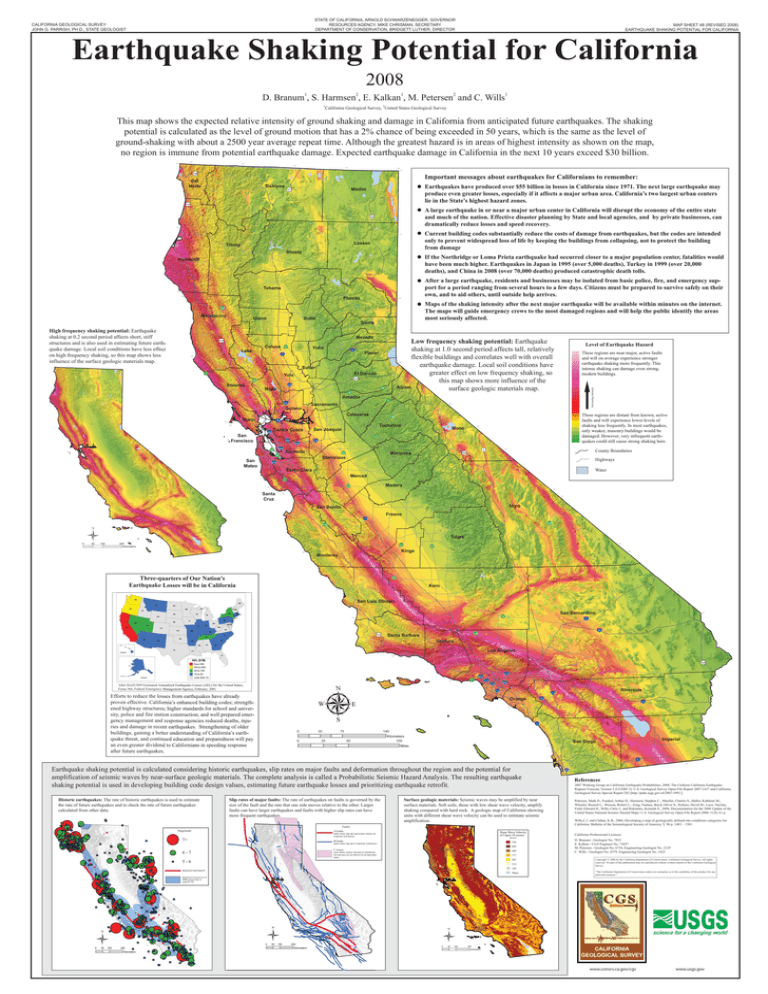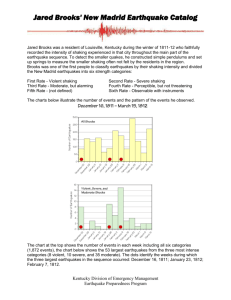Earthquake Shaking Potential for California 2008
advertisement

STATE OF CALIFORNIA, ARNOLD SCHWARZENEGGER, GOVERNOR RESOURCES AGENCY, MIKE CHRISMAN, SECRETARY DEPARTMENT OF CONSERVATION, BRIDGETT LUTHER, DIRECTOR CALIFORNIA GEOLOGICAL SURVEY JOHN G. PARRISH, PH.D., STATE GEOLOGIST MAP SHEET 48 (REVISED 2008) EARTHQUAKE SHAKING POTENTIAL FOR CALIFORNIA Earthquake Shaking Potential for California 2008 D. Branum1, S. Harmsen2, E. Kalkan1, M. Petersen2 and C. Wills1 1 California Geological Survey, 2United States Geological Survey This map shows the expected relative intensity of ground shaking and damage in California from anticipated future earthquakes. The shaking potential is calculated as the level of ground motion that has a 2% chance of being exceeded in 50 years, which is the same as the level of ground-shaking with about a 2500 year average repeat time. Although the greatest hazard is in areas of highest intensity as shown on the map, no region is immune from potential earthquake damage. Expected earthquake damage in California in the next 10 years exceed $30 billion. 124° 42° 123° 122° 121° 120° 42° Important messages about earthquakes for Californians to remember: Del Norte Siskiyou Earthquakes have produced over $55 billion in losses in California since 1971. The next large earthquake may produce even greater losses, especially if it affects a major urban area. California’s two largest urban centers lie in the State’s highest hazard zones. Modoc A large earthquake in or near a major urban center in California will disrupt the economy of the entire state and much of the nation. Effective disaster planning by State and local agencies, and by private businesses, can dramatically reduce losses and speed recovery. 41° Current building codes substantially reduce the costs of damage from earthquakes, but the codes are intended only to prevent widespread loss of life by keeping the buildings from collapsing, not to protect the building from damage 41° Lassen Trinity Shasta If the Northridge or Loma Prieta earthquake had occurred closer to a major population center, fatalities would have been much higher. Earthquakes in Japan in 1995 (over 5,000 deaths), Turkey in 1999 (over 20,000 deaths), and China in 2008 (over 70,000 deaths) produced catastrophic death tolls. Humboldt After a large earthquake, residents and businesses may be isolated from basic police, fire, and emergency support for a period ranging from several hours to a few days. Citizens must be prepared to survive safely on their own, and to aid others, until outside help arrives. Tehama 40° 124° Plumas Mendocino Glenn 40° Maps of the shaking intensity after the next major earthquake will be available within minutes on the internet. The maps will guide emergency crews to the most damaged regions and will help the public identify the areas most seriously affected. Butte Sierra High frequency shaking potential: Earthquake shaking at 0.2 second period affects short, stiff structures and is also used in estimating future earthquake damage. Local soil conditions have less effect on high frequency shaking, so this map shows less influence of the surface geologic materials map. Nevada Colusa Low frequency shaking potential: Earthquake shaking at 1.0 second period affects tall, relatively flexible buildings and correlates well with overall earthquake damage. Local soil conditions have greater effect on low frequency shaking, so this map shows more influence of the Alpine surface geologic materials map. Yuba Lake Placer 39° Level of Earthquake Hazard These regions are near major, active faults and will on average experience stronger earthquake shaking more frequently. This intense shaking can damage even strong, modern buildings. Sutter El Dorado Yolo Sonoma Napa Increasing intensity 39° Amador Sacramento Solano 119° Calaveras These regions are distant from known, active faults and will experience lower levels of shaking less frequently. In most earthquakes, only weaker, masonry buildings would be damaged. However, very infrequent earthquakes could still cause strong shaking here. Marin 38° Tuolumne 123° Contra Costa San Joaquin Mono 38° San Francisco 118° Alameda County Boundaries Mariposa Stanislaus San Mateo Highways Santa Clara Water Merced Madera 37° 37° Santa Cruz 122° 117° Inyo San Benito Fresno Tulare 0 50 100 200 Kilometers 116° Kings 36° 36° Monterey Three-quarters of Our Nation’s Earthquake Losses will be in California Kern 121° 115° San Luis Obispo San Bernardino 35° 35° Santa Barbara Ventura Los Angeles 120° 34° 119° After HAZUS99 Estimated Annualized Earthquake Losses (AEL) for the United States, Fema 366, Federal Emergency Management Agency, February, 2001 Riverside Efforts to reduce the losses from earthquakes have already proven effective. California’s enhanced building codes; strengthened highway structures; higher standards for school and university, police and fire station construction; and well prepared emergency management and response agencies reduced deaths, injuries and damage in recent earthquakes. Strengthening of older buildings, gaining a better understanding of California’s earthquake threat, and continued education and preparedness will pay an even greater dividend to Californians in speeding response after future earthquakes. Orange 118° Imperial San Diego 33° 33° 115° Earthquake shaking potential is calculated considering historic earthquakes, slip rates on major faults and deformation throughout the region and the potential for amplification of seismic waves by near-surface geologic materials. The complete analysis is called a Probabilistic Seismic Hazard Analysis. The resulting earthquake shaking potential is used in developing building code design values, estimating future earthquake losses and prioritizing earthquake retrofit. Historic earthquakes: The rate of historic earthquakes is used to estimate the rate of future earthquakes and to check the rate of future earthquakes calculated from other data. Slip rates of major faults: The rate of earthquakes on faults is governed by the size of the fault and the rate that one side moves relative to the other. Larger faults can have larger earthquakes and faults with higher slip rates can have more frequent earthquakes. Surface geologic materials: Seismic waves may be amplified by near surface materials. Soft soils, those with low shear wave velocity, amplify shaking compared with hard rock. A geologic map of California showing units with different shear wave velocity can be used to estimate seismic amplification. Faults Magnitude A Faults, faults where slip rate and seismic history are relatively well known 7+ B Faults, faults where slip rate is relatively well known Shear Wave Velocity of Upper 30 meters 6-7 5-6 Historical Fault Rupture areas where seismic slip may be distributed, but slip rates are not known for all individual faults References 2007 Working Group on California Earthquake Probabilities, 2008, The Uniform California Earthquake Rupture Forecast, Version 2 (UCERF 2): U.S. Geological Survey Open-File Report 2007-1437 and California Geological Survey Special Report 203 [http://pubs.usgs.gov/of/2007/1091/]. Petersen, Mark D., Frankel, Arthur D., Harmsen, Stephen C., Mueller, Charles S., Haller, Kathleen M., Wheeler, Russell L., Wesson, Robert L., Zeng, Yuehua, Boyd, Oliver S., Perkins, David M., Luco, Nicolas, Field, Edward H., Wills, Chris J., and Rukstales, Kenneth S., 2008, Documentation for the 2008 Update of the United States National Seismic Hazard Maps: U.S. Geological Survey Open-File Report 2008–1128, 61 p. Wills,C.J. and Clahan, K.B., 2006, Developing a map of geologically defined site-conditions categories for California: Bulletin of the Seismological Society of America, V. 96 p. 1483 – 1501. California Professional Licenses: (m/sec) 760 609 C Zones, 116° 489 D. Branum - Geologist No. 7821 E. Kalkan - Civil Engineer No. 73657 M. Petersen - Geologist No. 6754, Engineering Geologist No. 2129 C. Wills - Geologist No. 4379, Engineering Geologist No. 1423 377 287 216 Copyright © 2008 by the California Department of Conservation, California Geological Survey. All rights reserved. No part of this publication may be reproduced without written consent of the California Geological Survey. 160 Water “The California Department of Conservation makes no warranties as to the suitability of this product for any particular purpose.” Historical Occurrences of MMI greater than or equal to VII www.consrv.ca.gov/cgs www.usgs.gov







